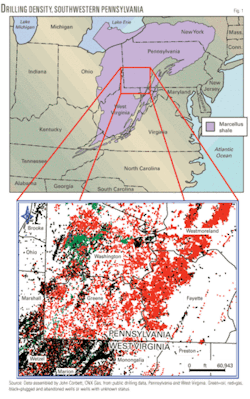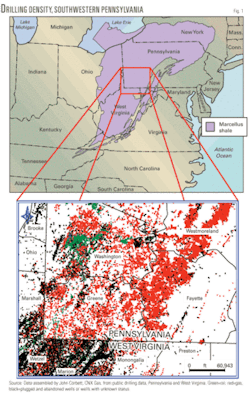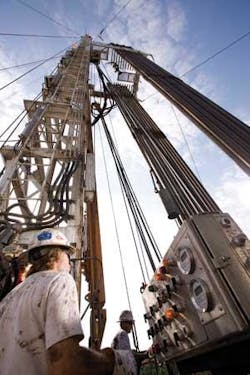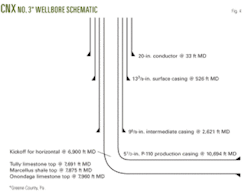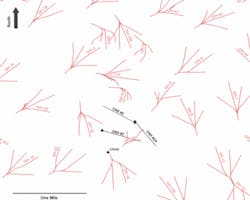Pittsburgh-based CNX Gas Corp., an exploration and production company that has drilled hundreds of coalbed-methane wells in the Appalachian basin, drilled its first horizontal Marcellus shale wells in Pennsylvania in 2008. The CNX No. 3 well was spud June 3 and began producing 6.5 MMcfd of natural gas in December.1
The CNX No. 3 was drilled horizontally through the Marcellus formation on company-owned mineral land in the Rogersville Quadrangle, Greene County, Pa. (Fig. 1).
The well was drilled to a vertical depth of 8,140 ft in the Huntersville Chert, penetrating 83 vertical ft of Marcellus shale. The well was logged, plugged back, and then CNX cut a horizontal section of 3,395 ft for a total measured depth of 10,738 ft. The well was completed with a five-stage slickwater fracture treatment using 3 million lb of proppant.
Tale of two rigs
CNX used two rigs to drill three horizontal Marcellus shale wells (3, 2, and 2a):
Top holes
CNX wrote a day-rate contract to use Crown Drilling Rig No. 7, a Speedstar 185 with top drive and hook load capacity of 185,000 lb. The rig’s maximum depth capability is about 8,500 ft in an air-drilled hole.
CNX used it to drill a vertical Marcellus well, CNX No. 4, and top holes of three horizontal wells: CNX No. 3, No. 2, and No. 2A.
Crown Drilling Rig 7 moved on location and set 33 ft of 20-in. diameter conductor pipe in June. The Crown Drilling crew drilled a 171/2-in. diameter hole with air to a depth sufficient to set 556 ft of 133/8-in.-diameter surface casing. They next drilled a 121/4-in. hole with foam mist to 2,680 ft.
CNX then logged the hole in support of the company’s coalbed-methane development drilling program. After logging, Crown set and cemented 2,630 ft of 95/8-in. intermediate casing (36 lb/ft, J-55 grade).
On June 16, 2008, Crown Rig No. 7 moved off the CNX No. 3 well and went on to drill top holes the CNX No. 2 and CNX No. 2A. Both wells were drilled from a single surface location, about a half-mile northeast of the CNX No. 3.
After the three horizontal wells, the rig returned to its previous task of drilling horizontal coalbed-methane wells for CNX. It also drilled three vertical Marcellus wells for CNX:
- GHCV No. 12—targeted to the Marcellus but came in “natural” in U Devonian sands.
- GHCV No. 8.
- GHCV No. 2.
Heavier rig
Privately held Les Wilson Inc., based in Carmi, Ill., drilled three horizontal wells for CNX under a day-rate contract. Les Wilson Rig 25 is an IDECO model H-44 double, capable of handling a 318,000 lb hook load. CNX Gas added a top drive. The rig drilled the CNX No. 3, CNX No. 2, and CNX No. 2A, and was then released and demobilized to Mississippi.
Drilling, logging
On June 21, the Les Wilson Drilling Co. Rig 25 moved onto location and rigged up (Fig. 2). Workers installed a 5,000 lb, 95/8-in. casinghead and mounted the blowout preventer. Drillers ran an 83/4-in. diamond bit, bit sub, 8-in. air hammer, and 61/2-in. drill collars in the hole. They tested BOPs and flowlines and once the safety protocols were completed, the company began drilling the production hole (Fig. 3).
On June 30, operations were suspended for a 5-hr safety inspection when a gas monitor malfunctioned. Once it was determined there was no threat to the safety of the crews or residents of the area, drilling operations resumed.
Les Wilson crews drilled the 83/4-in. hole to a total depth of 8,121 ft, with “good gas shows and occasional high torque (which is indicative of natural fractures) in the Marcellus,” according to John C. Corbett, petroleum geologist at CNX Gas.
CNX ran another set of openhole wireline logs in the well to evaluate the Marcellus and to determine a point at which to place the horizontal leg. The well was then plugged back to 6,136 ft. The plug was dressed to 6,200 ft and the directional assembly was run in the hole. The hole was drilled to a kickoff point of 7,300 ft.
On July 21, 2008, at 7,527 ft, while a Les Smith drilling crew was drilling the curve with a foam-mist, the soap injector failed and the drill pipe became stuck. To free the drillstring, the bottomhole assembly and two joints of drill pipe were left on bottom. Attempts to fish the BHA were unsuccessful, and on July 24 a new kickoff plug was set at 6,600 ft. After dressing the plug and rolling the hole with mud, Les Smith drillers ran a new BHA and resumed drilling at a measured pace until it determined that the well was kicked off.
The cuttings were at first all cement as CNX began to try to get off the kickoff plug and out of the old wellbore. Then the cuttings were 95% cement and 5% formation, and then, as they began to cut into new formation, cuttings were 50% cement and 50% formation, Corbett said.
On July 30, 2008, at a depth of 6,900 ft, the cuttings were finally comprised solely of formation. The contractor then began “drilling the curve” (the horizontal) at 7,300 ft. The build was 8°-12°/100 ft through most of the curve. Houston-based Scientific Drilling International provided directional control.
Before the driller landed the lateral, the mud weight was raised to 12.5 ppg, and the directional BHA, including the Smith FHi21 roller cone bit, was tripped out for the horizontal assembly. This included a 2.0 motor (mud motor and 2° bent sub) and an 83/4-in. Smith six-blade PDC bit.
The lateral was drilled above the most organic part of the Marcellus in a calcareous shale interval in order to avoid hole problems. A 12.5-13.5 ppg mud was used throughout the lateral.
CNX reached TD of 10,738 ft on Aug. 11, 2008 (Fig. 4). The drillstring was tripped out and 10,694 ft of 51/2-in., 20 lb/ft, P-110 casing was run in the hole and cemented by Halliburton.
Stimulation
CNX completed the well in five stages with slick water fracs (fresh water with a polyacrylamide friction reducer and a surfactant). BJ Services Co. fracture-stimulated the well in five stages, pumping the first stage on Sept. 15, 2008 (see Table 1). Key Energy Services provided the coiled tubing unit with 2-in.diameter tubing.
Infrastructure
CNX Gas has a 100% working interest in the well and a 100% net revenue interest because CNX Gas does not pay a royalty to the surface owner. Because of the gathering infrastructure already in place from its CBM operations, CNX Gas was able to place the well on line immediately after retrieving frac fluids. Also, gas from production in southwestern Pennsylvania, as in other areas of Appalachia, typically receives a premium over NYMEX pricing.
Fig. 5 shows wellbore paths in CNX Gas Corp.’s CBM development above the deeper Marcellus program. The orange, bird foot-like features are CBM wells that are drilled with as many as four laterals from a single wellhead.
Corbett told OGJ the CBM production is low-btu gas that CNX has been treating to get the btu’s up to pipeline quality. The Marcellus gas is on the rich side and will need to be treated down to pipeline quality over much of the basin. CNX has the opportunity to blend the two streams to produce pipeline quality gas.
Production
On Oct. 22, CNX Gas reported that the CNX No. 3 well began flowing into the sales meter on Oct. 2, with an initial production rate of 1.2 MMcfd and 4,000 lb of back pressure.2
On Dec. 15, CNX reported that the well was producing 6.5 MMcfd of natural gas, “A record daily production rate for any well in the company’s history and believed to be among the highest reported by any Marcellus shale producer,” said the company in a press release.
CNX had gradually reduced the backpressure on the well since Oct. 2, allowing daily production to increase to about 4 MMcfd. On Dec. 12, new surface equipment was installed that enabled the well to flow at 6.5 MMcfd, with pressure still being held at 2,640 lb (Fig. 6). Cumulative production from the well before Dec. 12, 2008, was 106 MMcf.
Nicholas J. DeIuliis, president and chief executive officer of CNX Gas, said the company’s horizontal drilling expertise came from drilling “160 horizontal coalbed methane wells before drilling its first horizontal Marcellus shale well.”1
Future
CNX Gas told OGJ it picked up the Les Wilson No. 30 rig under a day-rate contract to begin its 2009 horizontal program. The rig has a 420,000-lb hook load, which will enable the company to drill more than two horizontal wells from the same location.
CNX Gas finished drilling its second and third verticals in October and hydraulically fractured one in December. It will frac the third vertical (GHCV No. 6) and one horizontal (CNX 2A) this month.
CNX Gas will provide updates on these wells during the company’s next earnings conference call, scheduled for Jan. 28, 2009.
References
- “CNX Gas Announces Record Marcellus Production; Increased Production Guidance,” news release, Dec. 15, 2008, www.cnxgas.com.
- “CNX Gas Reports Record Third Quarter Results,” news release, Oct. 22, 2008, www.cnxgas.com.
